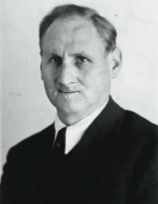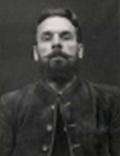The Perpetrators
August Hirt (1898 - 1945)
In 1963, the famous German author Rolf Hochhuth demonized Hirt in a profile that as the incarnation of evil. Hochhuth described the scientist as a gargantuan, imposing, drinker with a chest the size of a massive furnace—a man who cultivated the use of a cynically pleasant Swabian accent for evening rounds of beer because he knew well what a humorous, disarming effect it had. This passage can be read in the original in the German tragedy “Der Stellvertreter” (“The deputy”), which insinuates Pope Pius XII's indifference to Hitler's extermination of the Jews.
According to Hochhuth, Hirt would never have been found nor even even sought after, despite the fact that his fastidiously groomed idiocy and cruelty surpassed the degree typical of many other prominent physicians during that time.
Never found? Never even sought? Hochhuth’s conjecture was, in this case, without foundation. A look at the records of the Swiss Federal Public Prosecutor’s Office makes it clear that the authorities had a search warrant out for Hirt until the end of the 1950’s. The warrant was issued in Switzerland for two reasons. First, in August 1945, the specialist for intravital microscopy had apparently been sighted in area around Geneva. Secondly, Hirt was a Swiss citizen. As of 1921, he also had taken on German citizenship. Despite the warrant for his arrest, on June 2, 1945, August Hirt had already put an end to his life with a pistol shot to the heart. Hirt committed suicide near the Black Forest village of Schoenenbach where he had gone underground in April 1945. It took quite a long time, however, until this fact became generally known. It was for this reason that he was sentenced to death in absentia by a military court in Metz on December 23, 1953. Hirt remained on the most-wanted list of the Swiss Federal Public Prosecutor’s Office until 1959.
.
August Hirt
Sammlung Hans-Joachim Lang
August Hirt: His carreer
August Hirt was born on April 29, 1898 in Mannheim, Germany. He was the son of a Swiss plasterer who later became a liqueur manufacturer. Hirt was a comparatively poor student who had to repeat the 9th grade in 1912 because of his bad grades in Math and French. In 1914, at the age of 16, he voluntarily became a soldier in WWI. He stayed in the military for two years until a shot through his jaw temporarily brought the young teen back to his senses. Hirt returned to his high school in Mannheim and earned his degree in 1917.
August Hirt enrolled as a medical student at the university in Heidelberg. It was here that he also applied for the Swiss nationality in addition to his German citizenship. He also joined the nationalist fraternity “Normannia”. After 1930, Hirt, who had in the meantime become a university lecturer, organized paramilitary sports activities. By 1933, he had risen to become a professor of anatomy. On April 1st of that year, he also became a member of the SS. Later on, a colleague who had experienced Hirt as his instructor at the University of Heidelberg described him as a being a “parvenu arrogant person”
During those years in Heidelberg, Hirt conducted research on the renal nervous system. It was also during that time that he developed a new type of fluorescent microscope with the pharmacologist, Philipp Ellinger. The instrument would later become known as the “intravital microscope”. This technological innovation made it possible for the very first time for scientists to investigate living tissues that had been previously treated with a special dye. Hirt and the older, more experienced Ellinger, took out a patent on their discovery and the Zeiss company commercialized their idea. Despite this success, the relationship between the two scientists disintegrated. Ellinger was a Jew; and as a member of the SS, Hirt wanted nothing to do with him. After Ellinger immigrated to the United States, there was nothing or no one to hold his former partner back from reaping the scientific credits and financial royalties that came from the patented microscope.
In 1936, Hirt finally received a long hoped for career advancement in the form of a professorship at the Anatomy Department of the University of Greifswald. Two years later, he exchanged this appointment for a faculty position in Frankfurt am Main. It seems the wife of his Frankfurt colleague found the climate in the urban metropole as intolerable as Hirt’s own wife had found the weather at the Baltic Sea. Due to the time he spent as a volunteer military physician on the front, Hirt did not spend a great deal of time in the research activities of the Frankfurt faculty. As he had done in Greifswald, Hirt also served as the director of the Anatomy Department in Frankfurt. In the summer of 1941, when Hirt was hired by the University of Strasburg, he was also given the same position once again.
A few months after his arrival in Strasbourg, Hirt developed a plan with the SS scientific Society for ancestral heritage, the “Ahnenerb”e. The research plan would involve the expansion of the anthropological collection of his institute. The project would increase the collection, as Hirt formulated, “in accordance with modern perspectives”. Animal and human specimens had already been made available to physicians and the general public since the 18th century. In the early 19th century, the newly erected university institutes of anatomy and pathology had also begun to assemble such collections. The graphic nature of these collections served to amass and transmit knowledge about healthy and unhealthy bodies. In Germany, the most important museum of this ilk was founded by Rudolf Virchow at the end of the 19th century at the famous university clinic in Berlin, the Charité. Virchow recognized how much could be achieved within his discipline via this museum. The collection in Strasbourg was enlarged by the German anatomist, Gustav Schwalbe (1844-1916).
Hirt wanted to have skeletons extracted from the bodies of 86 Jewish men and women, whom he would have murdered in the Natzweiler-Struthof Concentration Camp. Using these skeletal remains, he planned to expand the anthropological collection of the institute in accordance with the racial ideological theories of the time. In addition to his inhuman experiments on other concentration camp prisoners to test antidotes for poisonous gasses, this plan added to his criminality. From local prison camps, Hirt also collected the bodies of Russian POWs which he used in various ways for instruction.
Before the arrival of the Allied Forces in Strasbourg, Hirt made his way to the German city of Tuebingen where the Reich University of Strasbourg and several institutes had already relocated. Once there, the anatomist was unable, however, to resume normal scientific activities. A few days before the French troops marched into Tuebingen, on the 19th of April 1945, the anatomist fled once again. He reached the Schluchsee, a reservoir lake in the Black Forest. One there, he first lived in a cabin deep in the woods, before then moving in with a local farmer’s family. On June 2, 1945, he committed suicide.
Wolfram Sievers (1905 - 1948)
Of all the people directly involved in the murder of the 86 Jewish men and women, Wolfram Sievers was the only one tried at the Nuremberg Medical Trials [Nürnberger Ärztetribunal]. This trial was one of twelve held by the International Military Tribunal against major war criminals. With General Telford Taylor at the helm, the court of US judges began its work on October 25, 1946. A little under two weeks later, formal charges were brought against 23 high-tanking Nazi doctors and officials of the National Socialist’s medical establishment. At the time of the indictment, all 23 had been placed in custody in Nuremberg.
.
On August 20, 1947, on the 143rd day of the trial, the court handed down its ruling. Along with six other accused, the SS colonel [Standartenführer] Sievers was sentenced to death by hanging. Sievers was found guilty of participating in and being responsible for not only prisoner experiments involving high-altitude, freezing, malaria, poisonous gas, sea water, jaundice, typhus; but also, the extermination of Jews for the completion of a skeleton collection.
In the explanation given for the final judgement, the court argued that Sievers had been for all intents and purposes served as the actual leader of the Ahnenerbe Society. In this capacity, he was the direct subordinate of Himmler and had regularly reported to him about the activities of the Society. With regard to the crimes committed against the 86 prisoners taken from Auschwitz, the court determined that Sievers had known from the first moment “that mass murder was planned for the procurement of the skeleton collection.” The prosecution further stated that “the pictures of the corpses and the dissecting rooms of the Institute, taken by the French authorities after the liberation of Strasbourg, point up the grim story of these deliberate murders to which Sievers was a party.” Moreover, the court ruled that though it was “true” that “
In the early hours of June 2, 1948, Siever’s death sentence was carried out in the courtyard of the Landsberg am Lech Prison.

Bruno Beger (1911 - 2009)
It was not until October 27, 1970 that the circuit court of Frankfurt filed charges against Bruno Beger and Hans Fleischhacker for murder and accessory to murder. Beger also was made to face charges of being one of the masterminds behind the homicidal plan involving the 86 Jewish men and women. Alongside Beger and Fleischhacker sat Wolf-Dietrich Wolff, a coworker of Wolfram Sievers in the Ahnenerbe Society.
In 1948, the anthropologist of the SS Society of the Ahnenerbe was classified as a follower of National Socialistm, a “Mitläufer”. He completed his de-nazification in Darmstadtbefore taking on a position as a salesman in the paper industry. As before, Beger remained captivated by his previous research areas. However, his interest manifested itself as a private hobby not openly motivated by racist ideology. Already in 1952, he embarked upon yet another expedition to Tibet. After that trip, many others followed.
After being found guilty of 86 counts of murder, Bruno Beger was given a minimal sentence of three years. The sentence was however reduced for the time he had already served in the Darmstadt prison between May 1, 1946 and February 2, 1948. According to the ruling from July 11, 1977 by the 20th district court of Frankfurt, the imprisonment was limited to the time not yet served of the sentence passed by the district court of Frankfurt on the 6th of April 1971 in connection with the ruling made on October 24, 1973 and in accordance with Paragraph 56g of the German penal code. The court ruled in favor of this reduction as the official investigations had, in the eyes of the justices, revealed nothing unfavorable about the person convicted.
Bruno Beger died on October 12, 2009 in Königstein in the Taunus region of Germany.
Hans Fleischhacker (1912 - 1992)
In 1948, Hans Fleischhacker, like his colleague, Bruno Beger, was classified as a follower of National Socialism [Mitläufer] by a communal tribunal. Like other faculty members, on October 25, 1945, his employment at the University of Tuebingen was terminated. On the orders of the French military government, his termination was “effective immediately”. Fleischhacker then found himself interred in US American prison camps— first in Karlsbad, Germany, and then later in Langwasser, near Nuremberg. Then, in December of 1946, he was sent to a French internment camp of Balingern, near Tuebingen. In March 1948, he was assigned to a camp work detail responsible for the location of POWs and the missing-in-action. The work detail was a part of the Ministry of the Interior of Southern Württemberg-Hohenzollern in Tuebingen. After his release from the camp, Fleischhacker remained a governmental employee, eventually advancing to the position of department head. He also became a court consultant for hereditary biology. In 1949, Professor Günther Just, a temporary head of the University of Tuebingen’s Anthropology Institute, formally applied for Fleischhacker’s reinstatement at the University. According to Just’s petition, Fleischhacker’s scientific publications were of a purely technical nature and have no discernible relationship to the doctrine of National Socialism. Apparently, Fleischhacker’s activities between June 1941 and October 1942 when he served as the department head of the Litzmannstadt branch of the SS’s Main Administrative Office for Race and Settlement [Rasse- und Siedlungshauptamt der SS] were also considered to be of a “purely professional technical nature.” Perhaps, the logic behind this incredible statement was based on the fact that Fleischhacker had collected material for his scientific research at this time. In fact, Fleischhacker obtained his post-doctoral degree [Habilitation] on the basis of research he had conducted on the finger prints that he had taken of Jews in the Litzmannstadt Ghetto. Litzmannstadt was the name that the Nazis used for the Polish city of Lodz.
Amongst his duties in Litzmannstadt, Fleischhacker instructed racial experts who were involved in the “Germanization of the Poles”. In November 1950, the anthropologist was able to resume his previous scientific path at the University of Frankfurt. From 1956 to 1959, he served as a guest researcher of the University of El Salvador. From January 1960 to October 1961, he was an assistant lecturer at the University of Tuebingen’s Anthropology Institute. From that point on, he was a lecturer at the Anthropology Institute of the University of Frankfurt. In May of 1968, he was temporarily suspended from this position because criminal charges had been lodged against him. However, after he was acquitted, he was able to resume his teaching duties at the University — only this time as a professor. The court in the Frankfurt trial against Fleischhacker had ruled in favor of separating the charge against him from the ongoing criminal proceedings. In March of 1971, he was found not guilty on the charge of accessory to murder. The court had accepted his contention that he had known nothing about the final fate of the people in Auschwitz who had been used for his anthropological measurements. He, like Beger, had succeeded in making people believe that his measurements had only one purpose: to compare scientific methods against one another, since the anthropologists involved came from different schools of thought but nevertheless had to a common mission within “Kommando K”.
Hans Fleischhacker died on January 30, 1992 in Frankfurt am Main.
Josef Kramer (1906-1945)
A professional bookkeeper, Josef Kramer became a member of the NSDAP in 1931. A year later, in 1932, he became a member of the SS and served in many different concentration camps. Among his many placements, in October 1942, he served as a commandant of the Natzweiler-Struthof Concentration Camp. From May to November 1944, he then served as the commandant of the Auschwitz-Birkenau Concentration Camp
Kramer murdered 29 women and 57 women whose bodies had been designated for use by the SS Society “Ahnenerbe”. Their remains were to become a part of a skeleton collection for the Reich University of Strasburg. During the Nuremberg Trials, Kramer gave a lengthy report about his specific actions in the commission of this crime. His description began with his activities on Wednesday, the 11th of August 1943.
Kramer weiter: »Mit Hilfe einiger SS-Leute kleidete ich sie vollständig aus und schob sie in die Gaskammer, als sie vollständig nackt waren. Als die Türe geschlossen war, fingen sie an zu brüllen. Nachdem die Türe geschlossen war, führte ich durch ein Rohr, das oben rechts vom Guckloch angebracht war, eine gewisse Menge von Salzen ein. Sodann schloss ich die Öffnung des Rohres mit einem Kork, der am Ende dieses Rohres angebracht war. Dieser Kork hatte ein Metallrohr. Dieses Metallrohr schleuderte das Salz und Wasser in die Innenseite der Öffnung der Kammer, von der ich gesprochen habe. Ich beleuchtete die Innenseite des Raumes mittels eines Schalthebels, der in der Nähe des Rohres angebracht war, und beobachtete durch das Guckloch, was innerhalb des Raumes vor sich ging. Ich habe gesehen, dass diese Frauen ungefähr noch eine halbe Minute geatmet haben, bevor sie auf den Boden fielen. Nachdem ich die Ventilation innerhalb des Schornsteines in Bewegung gebracht hatte, öffnete ich die Türen. Ich fand diese Frauen leblos am Boden liegen, und sie waren voll bedeckt mit Ausscheidungen. Am nächsten Morgen sagte ich zu den Krankenpflegern der SS, die Leichname in einen kleinen Wagen zu legen – es war ungefähr um 5.30 Uhr –, damit sie in das anatomische Institut gebracht werden könnten, so wie mich Professor Hirt gebeten hatte."
Kramer divided the homicidal actions across four evenings. On August 11th , he killed the first group of women and then on August 13th he murdered the second. On the 16th and the 18th of August he continued with his male victims.
It is not possible to imagine just how horrific these crimes must have been. When several of the bodies were found later in the basement of the Anatomy Institute 1 ½ years after the murder, the autopsies revealed multiple bruises and contusions that attested to the brutality of those horrific nights. Clearly, 15 people will not simply allow themselves to be shoved, naked, into a dark room measuring only 7.8 ft. wide, 11½ ft. deep, and 8 ½ ft. high (2.4m wide, 3.5m deep, and 2.6m high) without fighting for their lives. In different sources, it is contended that on one of these evenings a single woman, two women, or a man ether managed to escape or was shot for resisting. I, however, consider these depictions to be wrong as they all come from hearsay. This issue is explored in more detail in my book.
Kramer was sentenced to death on November 17, 1945 by a British Military Tribunal in Lueneberg. On December 13, 1945, he was executed in Hameln.


